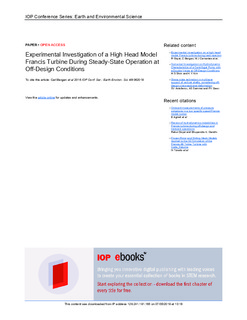| dc.contributor.author | Bergan, Carl Werdelin | |
| dc.contributor.author | Goyal, Rahul | |
| dc.contributor.author | Cervantes, Michel | |
| dc.contributor.author | Dahlhaug, Ole Gunnar | |
| dc.date.accessioned | 2019-05-08T06:42:17Z | |
| dc.date.available | 2019-05-08T06:42:17Z | |
| dc.date.created | 2017-01-02T17:54:54Z | |
| dc.date.issued | 2016 | |
| dc.identifier.citation | IOP Conference Series: Earth and Environment. 2016, 49 . | nb_NO |
| dc.identifier.issn | 1755-1307 | |
| dc.identifier.uri | http://hdl.handle.net/11250/2596874 | |
| dc.description.abstract | Francis-99 is a set of workshops aiming to determine the state of the art of high head Francis turbine simulations (flow and structure) under steady and transient operating conditions as well as promote their development and knowledge dissemination openly. The first workshop (Trondheim, 2014) focused on steady state conditions. Some concerns were raised regarding uncertainty in the measurements, mainly that there was no clear vortex rope at the Part Load (PL) condition, and that the flow exhibited relatively large asymmetry. The present paper addresses these concerns in order to ensure the quality of the data presented in further workshops.
To answer some of these questions, a new set of measurements were performed on the Francis- 99 model at Waterpower Laboratory at the Norwegian University of Science and Technology (NTNU). In addition to PL, two other operating conditions were considered, for further use in transient measurements, Best Efficiency (BEP) and High Load (HL). The experiments were carried out at a head of 12 m, with a runner rotational speed of 333 revolutions per minute (rpm). The guide vane opening angle were 6.72°, 9.84° and 12.43° for PL, BEP and HL, respectively. The part load condition has been changed from the first workshop, to ensure a fully developed Rotating Vortex Rope (RVR). The velocity and pressure measurements were carried out in the draft tube cone using 2D PIV and six pressure sensors, respectively. The new PL condition shows a fully developed rotating vortex rope (RVR) in both the frequency analysis and in the phase resolved data. In addition, the measurements confirm an asymmetric flow leaving the runner, as was a concern in the first Francis-99 workshop. This asymmetry was detected at both design and off-design conditions, with a stronger effect during off design. | nb_NO |
| dc.language.iso | eng | nb_NO |
| dc.rights | Navngivelse 4.0 Internasjonal | * |
| dc.rights.uri | http://creativecommons.org/licenses/by/4.0/deed.no | * |
| dc.title | Experimental Investigation of a High Head Model Francis Turbine During Steady-State Operation at Off-Design Conditions | nb_NO |
| dc.type | Journal article | nb_NO |
| dc.type | Peer reviewed | nb_NO |
| dc.description.version | publishedVersion | nb_NO |
| dc.source.pagenumber | 10 | nb_NO |
| dc.source.volume | 49 | nb_NO |
| dc.source.journal | IOP Conference Series: Earth and Environment | nb_NO |
| dc.identifier.doi | 10.1088/1755-1315/49/6/062018 | |
| dc.identifier.cristin | 1419533 | |
| dc.relation.project | Norges forskningsråd: 254987 | nb_NO |
| dc.relation.project | Norges forskningsråd: 257588 | nb_NO |
| dc.description.localcode | Content from this work may be used under the terms of the Creative Commons Attribution 3.0 licence. Any further distribution of this work must maintain attribution to the author(s) and the title of the work, journal citation and DOI. | nb_NO |
| cristin.unitcode | 194,64,25,0 | |
| cristin.unitname | Institutt for energi- og prosessteknikk | |
| cristin.ispublished | true | |
| cristin.fulltext | original | |
| cristin.qualitycode | 1 | |

